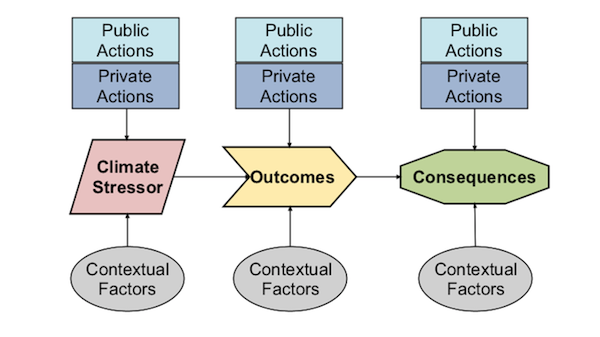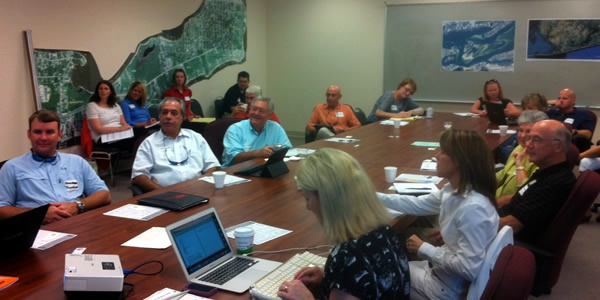The VCAPS Process
Overview
The Vulnerability, Consequences, and Adaptation Planning Scenarios (VCAPS) process, based on participatory modeling techniques, is a facilitated conversation that produces scenarios, represented by diagrams, linking climate and weather changes to local consequences. The diagrams also show opportunities for appropriate adaptation actions. The scenarios and diagrams are informed by the conceptual frameworks of causal structure of hazards and vulnerability.
A VCAPS diagram
VCAPS brings people with different perspectives and experience together and organizes their knowledge into an integrated diagram. Because the diagram shows how climate and weather changes create harm in a community, the group can easily identify opportunities for action to help make their community more resilient to an uncertain future. Many can benefit from VCAPS. Local government can improve its emergency services and ensure that key utilities such as water, sewer, electricity, and transportation remain operational. Individuals and organizations can take actions to protect their health, property and livelihoods.
The VCAPS Process
VCAPS is lead by a multi-person team consisting of a facilitator, climate expert, diagramming scribe(s), and note taker. While VCAPS can be implemented in a one-day workshop, it often works best with a series of meetings. The climate expert briefs the group on climate science information relevant to their region and poses questions for consideration during the discussion of impacts and management options. The participants decide where to focus their attention. The facilitator then guides discussions that collectively produce diagrams illustrating impacts of climate and weather on critical infrastructure, housing, livelihoods, etc. Discussions are informed by local knowledge and preferences and by the best available science. Through the diagramming process, participants identify actions to prevent impacts, to adapt in way that reduces the severity of potential impacts, or to increase resilience to potential impacts. The group distinguishes actions taken by government entities from those taken by private individuals and organizations. The results of the VCAPS process can be used by community leaders to determine where to allocate funding and resources.
A VCAPS meeting
The basic steps involved in implementing a VCAPS process include:
- Review background materials about the community, including existing hazards, hazard mitigation and climate adaptation strategies, etc.
- Contact key informants to identify participants and logistics, and then schedule workshops and invite participants.
- Conduct multiple facilitated meetings (aka diagramming sessions), with it being typical to have 2–4 meetings. The first meeting includes an introduction to VCAPS, presentation about locally relevant climate stressors, primer on VCAPS building blocks, and interactive diagramming time. Subsequent meetings include interactive diagramming time, reflections and wrap-up (e.g., next steps).
- Conduct follow-up participant interviews to gather feedback about the process and outcomes.
- Compile information developed during the facilitated meetings into a lessons learned document, which also includes the diagrams representing scenarios of climate change impacts and adaptation strategies.
Creating VCAPS Diagrams
The diagramming process is elaborated in our VCAPS User Guide. In general, we start simple, and gradually make the diagram more complex. With the meeting participants a management concern or issue (e.g., stormwater management) and climate stressor (e.g., more severe storm events) are selected to focus on. Through a facilitated discussion, participants are then asked to identify specific outcomes and consequences that can emerge from the climate stressor, contextual factors that influence the severity or likelihood of outcomes and consequences, and actions that can be taken to mitigate or adapt (by either public agencies or private parties). Completing a diagram can take 2-4 hours, depending on the level of complexity that group participants pursue.
We use a software package to create diagrams linking climate stressors, outcomes, consequences, information about vulnerabilities (i.e., contextual factors), and management actions about particular issues or management concerns (e.g., stormwater management, wastewater management, coastal infrastructure). We call these elements the building blocks of VCAPS. To create the diagrams we use the open source program Visual Understanding Environment (VUE).
In a VCAPS process the diagrams help in three specific ways:
- Organize and document local knowledge. The diagrams made with the program can serve as a library of what the community knows about the unique and special ways that it is vulnerable and resilient to different kinds of climate stressors. Gaps in knowledge or planning should be easy to spot. The community can then come up with a plan for filling in those gaps, if they are important.
- Identify strategies for hazard management and climate adaptation. The diagrams help participants identify actions that can be taken by the community to prevent or mitigate consequences, or to adapt to them. They can also give a clear understanding of where, what and how the community is already acting to address problems. As action-planning strategies, the diagrams are also helpful because they clarify where and when action needs to be taken.
- Support outreach and education activities. The diagrams can serve as useful visual aids to help explain decisions to residents. Community residents might want to better understand what the town is (or is not) doing to protect their property or safety and why (or why not). Transparency can help to build the support necessary for taking action, including the raising and spending of funds.
Building Systems Dynamic Models
VCAPS diagrams can be linked to visual data (databases and maps) and used to create systems dynamic (SD) models. System dynamics modeling approaches are ideal when a complex set of factors and feedbacks from multiple stressors impact a system’s function. Models are created by combining a combination of stocks (state variables) and flows (controls).
This structure permits system dynamics models to accommodate not only physical principles, but also assumptions about qualitative factors like policy options and factors best described using expert judgment. This ability to integrate physical principles with expert mental models makes system dynamics an intuitive methodology well-suited to bringing stakeholders into modeling processes through cooperative modeling groups aimed at addressing many environmental and resource management issues.
During a VCAPS process systems dynamic models can be made with the involvement of the local decision makers and stakeholders. These explore specific elements of the system in greater detail. They can be qualitative or quantitative models, depending on the needs of the local decision makers, the availability of data, and the maturity of the science.
 One advantage of focusing on the hazard rather than on the actions . . . if you focus on an action and it proves undoable for whatever reason, it comes full stop, but if you focus on the hazard and have a very clear understanding of the hazard, that simply means you go back to the diagram and identify another intervention point.
One advantage of focusing on the hazard rather than on the actions . . . if you focus on an action and it proves undoable for whatever reason, it comes full stop, but if you focus on the hazard and have a very clear understanding of the hazard, that simply means you go back to the diagram and identify another intervention point.
 Decisions by political organizations tend to be based on short term thinking that respond to immediate concerns; very little long term pro-active decision making is usually done. To examine potential issues with a long term perspective is fraught with controversy so not normally a part of the political decision process. The thought process with your tool requires the users to understand all consequences of the action, takes most of the emotionalism out, and provides fact-based documentation. This not only forces us to address the many consequences associated with the examination, but also creates a richer experience for all involved. These results provide us with fact-based defense when questioned by interested residents, especially those with self-interest in the outcome.
Decisions by political organizations tend to be based on short term thinking that respond to immediate concerns; very little long term pro-active decision making is usually done. To examine potential issues with a long term perspective is fraught with controversy so not normally a part of the political decision process. The thought process with your tool requires the users to understand all consequences of the action, takes most of the emotionalism out, and provides fact-based documentation. This not only forces us to address the many consequences associated with the examination, but also creates a richer experience for all involved. These results provide us with fact-based defense when questioned by interested residents, especially those with self-interest in the outcome.


